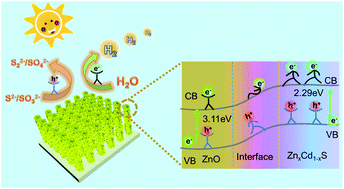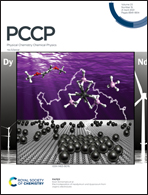Interface engineering of a hierarchical ZnxCd1−xS architecture with favorable kinetics for high-performance solar water splitting†
Abstract
Manipulating the charge carrier transport in photoactive materials is a big challenge toward high efficiency solar water splitting. Herein, we designed a hierarchical ZnxCd1−xS architecture for tuning the interfacial charge transfer kinetics. The in situ growth of ZnxCd1−xS nanoflakes on ZnO backbones provided low interfacial resistance for charge separation. With this special configuration, the optimized Zn0.33Cd0.67S photoanode achieved significantly enhanced performance with a photocurrent density of 10.67 mA cm−2 at 1.23 V versus RHE under AM1.5G solar light irradiation, which is about 14.1 and 2.5 times higher than that of the pristine ZnO and CdS nanoparticle decorated ZnO photoanodes, respectively. After coating a thin SiO2 layer, the photostability of the hierarchical Zn0.33Cd0.67S photoanode is greatly enhanced with 92.33% of the initial value retained under 3600 s continuous light illumination. The prominent PEC activity of the hierarchical ZnxCd1−xS nanorod arrays can be ascribed to an enhanced charge transfer rate aroused by the binder-free interfacial heterojunction, and the improved reaction kinetics at the electrode–electrolyte interface, which is evidenced by electrochemically active surface area measurements and intensity modulated photocurrent spectroscopy analysis. This interfacial heterojunction strategy provides a promising pathway to prepare high performance photoelectrodes.



 Please wait while we load your content...
Please wait while we load your content...